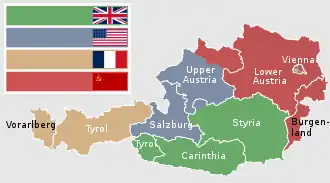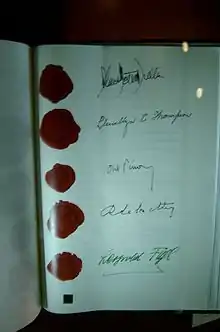| Type | Multilateral treaty |
|---|---|
| Signed | 15 May 1955 |
| Location | Vienna, Austria |
| Effective | 27 July 1955 |
| Parties |

.png.webp)

The Austrian State Treaty (German: Österreichischer Staatsvertrag [ˈøːstəraɪçɪʃɐ ˈʃtaːtsfɛɐ̯ˌtraːk] ⓘ) or Austrian Independence Treaty re-established Austria as a sovereign state.[2] It was signed on 15 May 1955 in Vienna, at the Schloss Belvedere among the Allied occupying powers (France, the United Kingdom, the United States, and the Soviet Union) and the Austrian government.[1] The neighbouring Federal People's Republic of Yugoslavia acceded to the treaty subsequently.[1] It officially came into force on 27 July 1955.[1]
Its full title is "Treaty for the re-establishment of an independent and democratic Austria, signed in Vienna on 15 May 1955" (German: Staatsvertrag betreffend die Wiederherstellung eines unabhängigen und demokratischen Österreich, unterzeichnet in Wien am 15. Mai).
Generalities and structure
The treaty re-established a free, sovereign and democratic Austria. The basis for the treaty was the Moscow Declaration of 30 October 1943. The agreement and its annexes provided for Soviet oilfield concessions and property rights of oil refineries in Eastern Austria and the transfer of the assets of the Danube Shipping Company to the USSR.[1]
Treaty signatories
- Allied foreign ministers:
- High commissioners of the occupying powers:
- Ivan I. Ilitchov (Soviet Union)
- Geoffrey Wallinger (United Kingdom)
- Llewellyn E. Thompson Jr. (United States)
- Roger Lalouette (France).
- Austrian foreign minister:
Nine parts of the treaty
- Preamble
- Political and territorial provisions
- Military and air travel provisions
- Reparations
- Ownership, Law and Interests
- Economic relations
- Rules for disputes
- Economic provisions
- Final provisions
Development
After the Anschluss in 1938, Austria had generally been recognized as part of Nazi Germany. In 1943, however, the Allies agreed in the Declaration of Moscow that Austria would instead be regarded as the first victim of Nazi aggression—without denying Austria's role in Nazi crimes—and treated as a liberated and independent country after the war.
In the immediate aftermath of World War II, the Allied occupation of Austria started on 27 April 1945 when Austria under Allied control claimed independence from Germany as a result of the Vienna Offensive. Austria was divided into four zones and jointly occupied by the United Kingdom, the Soviet Union, the United States, and France. Vienna was similarly subdivided, but the central district was collectively administered by the Allied Control Council.
Whereas Germany was divided into East and West Germany in 1949, Austria remained under joint occupation of the Western Allies and the Soviet Union until 1955; its status became a controversial subject in the Cold War. First attempts to negotiate a treaty were made by the first post-war government. However, they failed because the Allies wanted to see a peace treaty with Germany first. A treaty became less likely with the development of the Cold War. However, Austria successfully held its part of Carinthia against the demands of a resurgent Federal People's Republic of Yugoslavia, even though the issue of potential reunification with South Tyrol, annexed by Italy from Austria-Hungary in 1919, was not addressed.
The climate for negotiations improved with Joseph Stalin's death in 1953 and the warming of relations known as the Khrushchev Thaw. Negotiations with the Soviet foreign minister, Molotov, secured the breakthrough in February 1955.[3]
After Austrian promises of perpetual neutrality, Austria was accorded full independence on 15 May 1955, and the last occupation troops left on 25 October that year.
Important points in the treaty
As well as general regulations and recognition of the Austrian state, the minority rights of the Slovene and Croat minorities were also expressly detailed. Anschluss (Austria's political union with Germany), as had happened in 1938, was forbidden (German recognition of Austria's sovereignty and independence and renunciation by Germany of territorial claims over Austria were later covered in general terms in the 1990 Treaty on the Final Settlement with Respect to Germany about existing borders, but not specifically). Nazi and fascist organisations were prohibited.
Austrian neutrality is actually not in the original text of the treaty but was declared by parliament on 26 October 1955, after the last Allied troops were to leave Austria according to the treaty.
Result
As a result of the treaty the Allies left Austrian territory on 25 October 1955. 26 October came to be celebrated as a national holiday (called the Day of the Flag until 1965). It is sometimes thought to commemorate the withdrawal of Allied troops, but in fact celebrates Austria's Declaration of Neutrality, which was passed on 26 October 1955.
See also
References
- 1 2 3 4 5 Slusser, Robert M.; Triska, Jan F. (1959). A Calendar of Soviet Treaties 1917-1957. Stanford: Stanford University Press. p. 328.
- ↑ Maier, Charles S.; Bischof, Günter; Ruggenthaler, Peter; Stourzh, Gerald; Mueller, Wolfgang (2021-11-01). "The Austrian State Treaty and the Cold War: Contending Perspectives". Journal of Cold War Studies. 23 (4): 211–245. doi:10.1162/jcws_c_01045. ISSN 1520-3972. S2CID 241566469.
- ↑ "Austrian State Treaty, 1955". 2001-2009.state.gov. 18 July 2008. Retrieved 2017-06-15.
External links
- Full Text of the Treaty
- www.staatsvertrag.at - an acoustic web exhibition on the "Austrian Independence Treaty" (in German)
- Federal Chancellor Leopold Figl exhibits the freshly signed State Treaty document to the waiting crowd (Video) (in German)
- Austria is free (in German)
- Website of the 2005 Jubilee Year
- Counter-website to the 2005 national celebrations (in German)